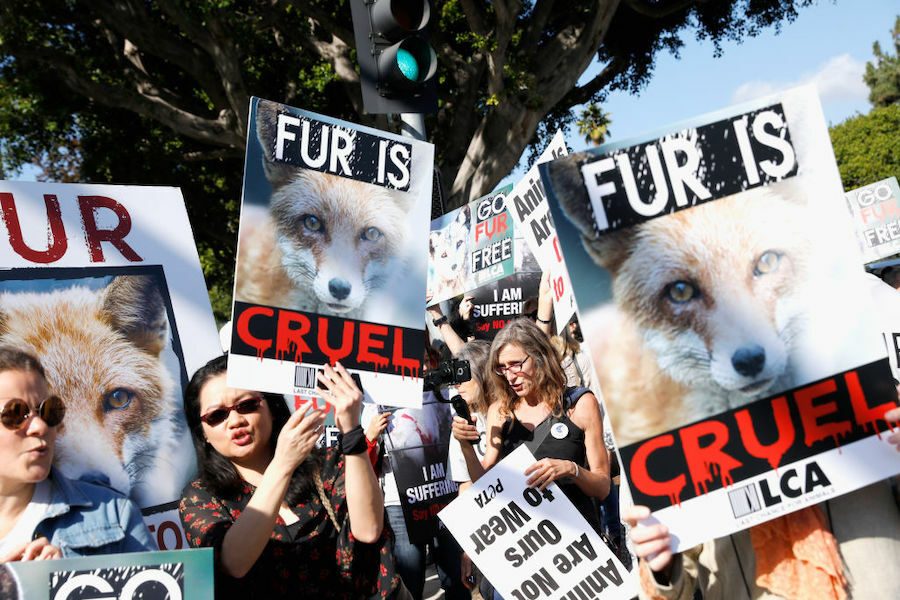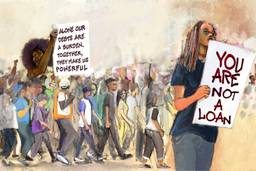From Fur to Foie Gras: Animals Are on a Winning Streak
While Trump has loosened some federal protections for animals, activists are gaining ground on the local and state level.
Andrew Schwartz

Activists with Slaughter Free Chicago (SFC) gathered November 7 at City Hall to push the city — once, says SFC founder Robert Grillo, the “slaughter capital of the world” — to eliminate its remaining slaughterhouses. Dozens of protesters sang, spoke with mayoral staff, and invoked the memory of the socialist writer Upton Sinclair, whose book The Jungle exposed the squalid working conditions of the city’s meatpackers.
Published in 1906, Sinclair’s novel galvanized landmark legislation empowering the federal government to regulate meat quality. But the plight of the workers themselves (let alone the animals they killed) went largely unaddressed. “I aimed for the public’s heart,” Sinclair famously wrote, “and by accident hit it in the stomach.”
The latest wave of slaughterhouse critics hopes this time, it can hit the heart.
On the surface, the situation for animals is grim: The Trump administration has loosened government protections in areas from wildlife refuges to trophy hunting to the meat industry, and climate emergency is poised to threaten wild animal populations worldwide. Though Trump did sign a federal ban on intentional animal cruelty November 25, it specifically exempts farms, slaughterhouses, hunters, fishers and research labs, rendering its scope limited. But a series of high-profile animal rights victories has swept the country in recent weeks, suggesting more substantive reform may be possible.
On October 30, activists in the public gallery at a New York City Council meeting thrust jazz hands to the air in celebration of a ban on foie gras produced from force-feeding, amid a raft of animal welfare legislation that included the establishment of a city office explicitly dedicated to animal welfare concerns, new data-keeping requirements on animal cruelty reports, vaccination requirements, equine working conditions, and regulations promoting shelter adoption — many of which reflect active ongoing campaigns elsewhere. Mayor Bill De Blasio signed the legislation November 25.
Earlier in October, California Gov. Gavin Newsom signed laws banning the manufacture or sale of new fur products, as well as the use of most animals in circus acts. In August, Illinois became the third state to outlaw the sale of cosmetics tested on nonhuman animals, following California and Nevada. And in Milwaukee, activists organized a successful resistance against a proposed plan to build a slaughterhouse in a long-vacant north Milwaukee business park, in a campaign partly inspired by SFC.
The 21th century, thanks in part to activist efforts, has seen a “loosening up of the instrumental perspective on animal use,” says Bernie Unti. Unti, a senior policy adviser to the president of the Humane Society of the United States (HSUS), has written extensively on the history of the animal protection movement. In the early-to-mid 20th century, Unti says, the movement largely focused on more modest campaigns such as those surrounding dogs and cats in pounds; a fast-growing meat industry parried any more ambitious proposals. But shift in public attitude, combined with technological innovations in clothing, research and fake meat, is making reforms an easier lift than in decades past.
“A common misconception about animal rights activists is that we only care about nonhuman animals, and that we’re discrediting human culture and human behavior,” says Amy Zignego, who helped organize the Milwaukee campaign. “We always have to be really sensitive. We don’t want to be perceived as a bunch of white vegans.”
Of the dozens of business-park neighbors whose doorbells activists rang, Zignego said, only one person had even heard about the slaughterhouse development plan, which was, at the time poised to proceed with little debate. Acting quickly, activists successfully pushed to delay the vote. The district’s alderman initially backed the proposed slaughterhouse on account of its potential to provide jobs and accused activists of “selective indignation” Ultimately, however, citing an “overwhelming response from neighbors in opposition to the project,” he changed his mind. The slaughterhouse company pulled out.
Zignego says the campaign aimed for an “intersectional” approach, arguing that the deleterious effects she associates with slaughterhouses — noise, pollution, and low-quality work — animated the activists just as did straightforward animal welfare concerns.
But there can also be tensions when human and nonhuman interests appear to diverge. The fur debates which have raged in California and New York — where the City Council speaker proposed a ban earlier this year — have in some cases stoked resentments along racial lines. The president of California’s Black Business Association, for instance, accused the anti-fur campaign of “ignorance,” citing the cultural significance of fur among black women. Corporations help fuel these tensions: The Intercept found that some California fur advocates received previously undisclosed payments from an industry organization.
Some activists acknowledge that many high-profile movement victories — even substantive ones — can feel somewhat parochial: Queen Elizabeth fur free; Pfizer banned a forced swim test, Walmart ends live fish sales. But many believe such narrower campaigns can effectively pave the way for change on a larger scale.
The Berkeley, Calif.-based grassroots advocacy group Direct Action Everywhere (DxE) pushed for the statewide fur ban, but press coordinator Matt Johnson clarified the specificity of the issue did not reflect the scope of the group’s ambitions, which include the end of all animal exploitation for food, clothing, science and entertainment. But the statewide law, following municipal fur bans implemented in municipalities like Los Angeles and San Francisco, is consistent with the pattern laid forth in DxE’s 40-year “strategic roadmap.” This roadmap emphasizes local seed activism — with Berkeley as the epicenter — to forcefully push the proverbial Overton Window, fundamentally transforming how the public and the legal system conceive of nonhuman animals.
DxE formed this decade, and has gained prominence through its “open rescue” actions whereby activists enter a farm without authorization, document conditions and take with them animals in need. The strategy, which predates the organization, strives to extend legal precedent and to publicize mistreatment of animals. The group takes particular aim at source farms for retailers like Whole Foods that advertise as more humane.
A meat industry report showed that, while 2017 saw a slightly reduced volume of meat sales from the previous year, sales of meat with “production claims” like “antibiotic-free” or “organic” increased by more than 38%. For Johnson, this dual trend embodies the shortfalls of consumer-based rhetoric, which he doubts can galvanize the fundamental change he desires. Unti from HSUS sees validity in such criticisms, but still takes heart in the fact that more consumers experience a moral churn as they choose their eggs.
Ultimately, both activists agreed the movement must shake its reputation of self-righteousness — justified or not — to be successful.
Critics, Unti says, have charged that animal rights activists are “good at one thing: saying ‘shh, tsk tsk.’ Telling people what they should not do.”
“The message is so much centered around ‘go vegan,’ ” Johnson says. “It gives people this impression that you’re either in the snobby holier-than-thou club that no one really wants to be in, or anyone in that club thinks that you’re an evil person.”
Instead, he suggests, advocates’ message should be “systems-focused. People are on your side if you can craft that message. It feels like we should be at the tipping point.”







